Formation with Non-Collision Control Strategies for Second-Order Multi-Agent Systems
Abstract
1. Introduction
2. Problem Statement
- 1.
- A set of vertices N corresponding to the n agents in the system.
- 2.
- A set of edges , which denotes the agent receive information from .
- 3.
- A set of labels , where is a vector that specifies the relative position between agents and .
- 1.
- , for all ;
- 2.
- when ;
- 3.
- , for all .
- The second-order multi-agent system avoids collisions among them, i.e.,where d is the safety distance.
- The agents reach a desired geometric pattern, i.e.,where, given a communication graph , the desired position of each agent is defined aswith are constant vectors which specify the desired relative position among the agents.
3. Control Strategy
3.1. Formation Control
3.2. Collision Avoidance Control
4. Numerical Simulations
4.1. Two Agents
4.2. Ten Agents with a Mixed Graph Communication Topology
5. Conclusions
Author Contributions
Funding
Institutional Review Board Statement
Data Availability Statement
Conflicts of Interest
Abbreviations
| RVFs | Repulsive Vector Fields |
| RPA | Repulsive Potential Approach |
| MDPI | Multidisciplinary Digital Publishing Institute |
References
- Khatib, O. Real-time obstacle avoidance for manipulators and mobile robots. In Proceedings of the 1985 IEEE International Conference on Robotics and Automation, St. Louis, MO, USA, 25–28 March 1985; Volume 2, pp. 500–505. [Google Scholar] [CrossRef]
- Hernández-Martínez, E.G.; Aranda-Bricaire, E. Convergence and Collision Avoidance in Formation Control: A Survey of the Artificial Potential Functions Approach. In Multi-Agent Systems; Alkhateeb, F., Maghayreh, E.A., Doush, I.A., Eds.; IntechOpen: Rijeka, Croatia, 2011; Chapter 6; pp. 103–126. [Google Scholar] [CrossRef]
- Flores-Resendiz, J.F.; Aranda-Bricaire, E.; González-Sierra, J.; Santiaguillo-Salinas, J. Finite-time formation control without collisions for multiagent systems with communication graphs composed of cyclic paths. Math. Probl. Eng. 2015, 2015, 948086. [Google Scholar] [CrossRef]
- Santiaguillo-Salinas, J.; Aranda-Bricaire, E. Containment problem with time-varying formation and collision avoidance for multiagent systems. Int. J. Adv. Robot. Syst. 2017, 14, 1–13. [Google Scholar] [CrossRef]
- Flores-Resendiz, J.F.; Aranda-Bricaire, E. A general solution to the formation control problem without collisions for first order multi-agent systems. Robotica 2020, 38, 1123–1137. [Google Scholar] [CrossRef]
- Hernandez-Martinez, E.; Aranda-Bricaire, E. Non-Collision Conditions in Multi-Agent Virtual Leader-Based Formation Control. Int. J. Adv. Robot. Syst. 2012, 9, 100. [Google Scholar] [CrossRef]
- Dou, L.; Yu, X.; Liu, L.; Wang, X.; Feng, G. Moving-Target Enclosing Control for Mobile Agents with Collision Avoidance. IEEE Trans. Control. Netw. Syst. 2021, 8, 1669–1679. [Google Scholar] [CrossRef]
- Hu, J.; Zhang, H.; Liu, L.; Zhu, X.; Zhao, C.; Pan, Q. Convergent Multiagent Formation Control with Collision Avoidance. IEEE Trans. Robot. 2020, 36, 1805–1818. [Google Scholar] [CrossRef]
- Mao, R.; Dai, H. Distributed Non-Convex Model Predictive Control for Non-Cooperative Collision Avoidance of Networked Differential Drive Mobile Robots. IEEE Access 2021, 10, 52674–52685. [Google Scholar] [CrossRef]
- Panagou, D. Motion planning and collision avoidance using navigation vector fields. In Proceedings of the 2014 IEEE International Conference on Robotics and Automation (ICRA), Hong Kong, China, 31 May–7 June 2014; pp. 2513–2518. [Google Scholar] [CrossRef]
- Raj, J.; Raghuwaiya, K.; Vanualailai, J. Collision Avoidance of 3D Rectangular Planes by Multiple Cooperating Autonomous Agents. J. Adv. Transp. 2020, 2020, 4723687. [Google Scholar] [CrossRef]
- Sakai, D.; Fukushima, H.; Matsuno, F. Leader-follower navigation in obstacle environments while preserving connectivity without data transmission. IEEE Trans. Control. Syst. Technol. 2018, 26, 1233–1248. [Google Scholar] [CrossRef]
- Seung-Mok, L.; Hyun, M. Receding horizon particle swarm optimisation-based formation control with collision avoidance for non-holonomic mobile robots. IET Control Theory Appl. 2015, 9, 2075–2083. [Google Scholar] [CrossRef]
- Hernandez-Martinez, E.; Aranda-Bricaire, E. Collision Avoidance in Formation Control using Discontinuous Vector Fields. IFAC Proc. Vol. 2013, 46, 797–802. [Google Scholar] [CrossRef]
- Vargas, S.; Becerra, H.M.; Hayet, J.B. MPC-based distributed formation control of multiple quadcopters with obstacle avoidance and connectivity maintenance. Control Eng. Pract. 2022, 121, 105054. [Google Scholar] [CrossRef]
- Gnanasekera, M.; Katupitiya, J. A Time-Efficient Method to Avoid Collisions for Collision Cones: An Implementation for UAVs Navigating in Dynamic Environments. Drones 2022, 6, 106. [Google Scholar] [CrossRef]
- Yasin, J.N.; Mohamed, S.A.S.; Haghbayan, M.H.; Heikkonen, J.; Tenhunen, H.; Plosila, J. Unmanned Aerial Vehicles (UAVs): Collision Avoidance Systems and Approaches. IEEE Access 2020, 8, 105139–105155. [Google Scholar] [CrossRef]
- Dang, A.D.; La, H.M.; Nguyen, T.; Horn, J. Formation control for autonomous robots with collision and obstacle avoidance using a rotational and repulsive force–based approach. Int. J. Adv. Robot. Syst. 2019, 16, 1–16. [Google Scholar] [CrossRef]
- Yoo, S.J.; Kim, T.H. Distributed formation tracking of networked mobile robots under unknown slippage effects. Automatica 2015, 54, 100–106. [Google Scholar] [CrossRef]
- Yoo, S.J.; Park, B.S. Connectivity preservation and collision avoidance in networked nonholonomic multi-robot formation systems: Unified error transformation strategy. Automatica 2019, 103, 274–281. [Google Scholar] [CrossRef]
- Park, B.S.; Yoo, S.J. Connectivity-Maintaining and Collision-Avoiding Performance Function Approach for Robust Leader–Follower Formation Control of Multiple Uncertain Underactuated Surface Vessels. Automatica 2021, 127, 109501. [Google Scholar] [CrossRef]
- Li, S.; Wang, X. Finite-time consensus and collision avoidance control algorithms for multiple AUVs. Automatica 2013, 49, 3359–3367. [Google Scholar] [CrossRef]
- Liu, J.; Zhao, M.; Qiao, L. Adaptive barrier Lyapunov function-based obstacle avoidance control for an autonomous underwater vehicle with multiple static and moving obstacles. Ocean Eng. 2022, 243, 110303. [Google Scholar] [CrossRef]
- Yang, S.; Weiwei, B.; Li, T.; Shi, Q.; Yang, Y.; Yue, W.; Chen, C. Neural-network-based Formation Control with Collision, Obstacle Avoidance and Connectivity Maintenance for a Class of Second-order Nonlinear Multi-Agent Systems. Neurocomputing 2021, 439, 243–255. [Google Scholar] [CrossRef]
- Liu, X.; Li, C.; Li, D. Collision-avoiding formation for multiple Euler–Lagrange systems against external disturbances and actuator faults. J. Frankl. Inst. 2022, 359, 6336–6360. [Google Scholar] [CrossRef]
- Ajwad, S.A.; Moulay, E.; Defoort, M.; Ménard, T.; Coirault, P. Collision-Free Formation Tracking of Multi-Agent Systems Under Communication Constraints. IEEE Control Syst. Lett. 2021, 5, 1345–1350. [Google Scholar] [CrossRef]
- Sun, Q.; Wang, X.; Chen, Y.H. Satellite Formation-Containment Control Emphasis on Collision Avoidance and Uncertainty Suppression. IEEE Trans. Cybern. 2022, 1–14. [Google Scholar] [CrossRef]
- Flores-Resendiz, J.; Avilés, D.; Aranda-Bricaire, E. Formation Control for Second-Order Multi-Agent Systems with Collision Avoidance. Machines 2023, 11, 208. [Google Scholar] [CrossRef]
- Abraham, R.; Marsden, J.E.; Ratiu, T. Manifolds, Tensor Analysis, and Applications; Number 2 in Applied Mathematical Sciences; Springer: New York, NY, USA, 1988. [Google Scholar]
- Spivak, M. A Comprehensive Introduction to Differential Geometry; Number v. 1 in A Comprehensive Introduction to Differential Geometry; Publish or Perish, Incorporated: Houston, TX, USA, 1999. [Google Scholar]
- Godsil, C.; Royle, G. Algebraic Graph Theory. In Graduate Texts in Mathematics; Springer: New York, NY, USA, 2001; Volume 207. [Google Scholar]
- Ren, W.; Beard, R.W. Distributed Consensus in Multi-Vehicle Cooperative Control: Theory and Applications. In Communications and Control Engineering Series; Springer: London, UK, 2008. [Google Scholar]
- Teel, A.R. Global stabilization and restricted tracking for multiple integrators with bounded controls. Syst. Control Lett. 1992, 18, 165–171. [Google Scholar] [CrossRef]
- Tatsch, A.; Fitz-Coy, N. Dynamic artificial potential function guidance for autonomous on-orbit servicing. In Proceedings of the 6th International ESA Conference on Guidance, Navigation and Control Systems, Loutrak, Greece, 17–20 October 2005; pp. 1–6. [Google Scholar]

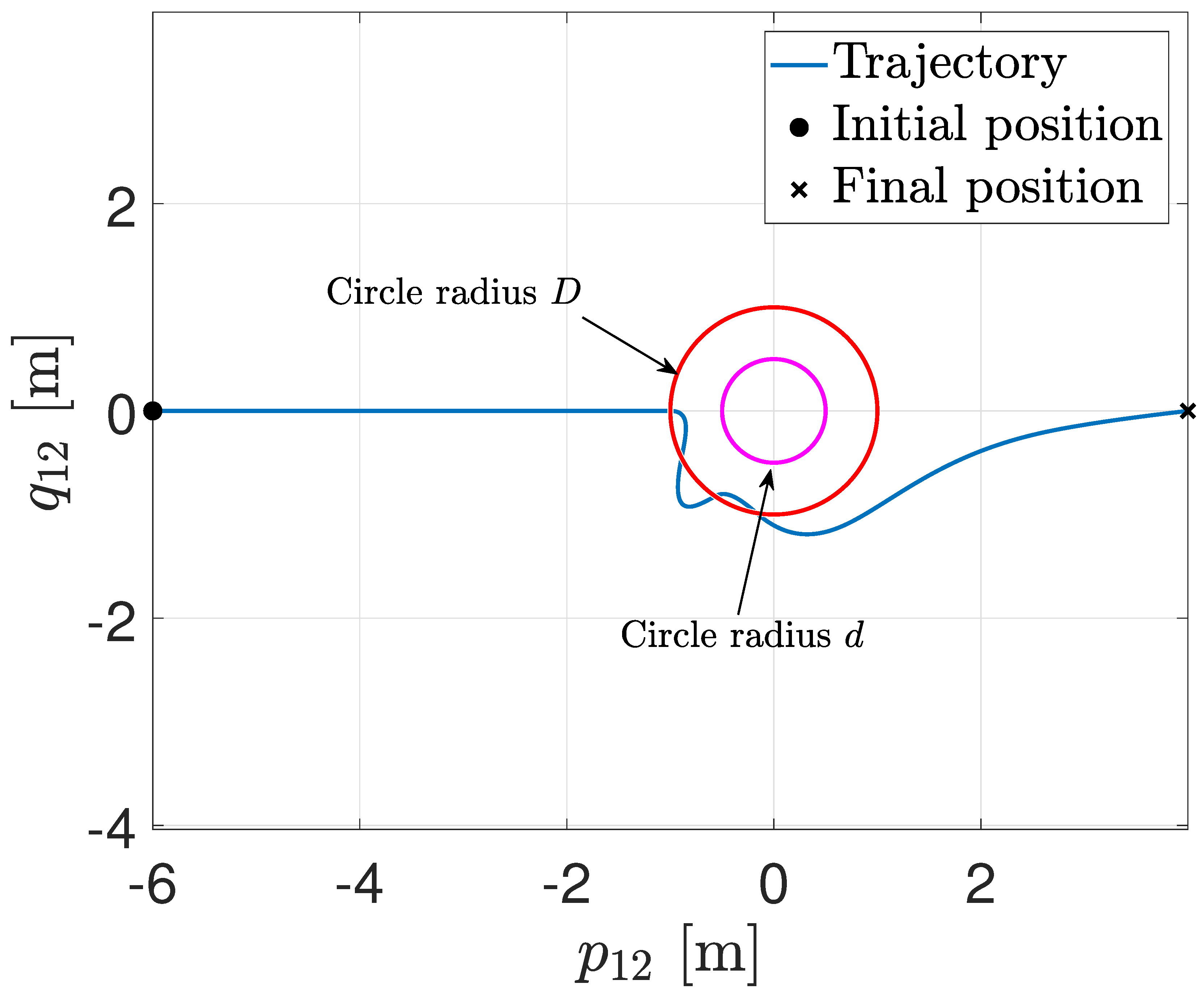
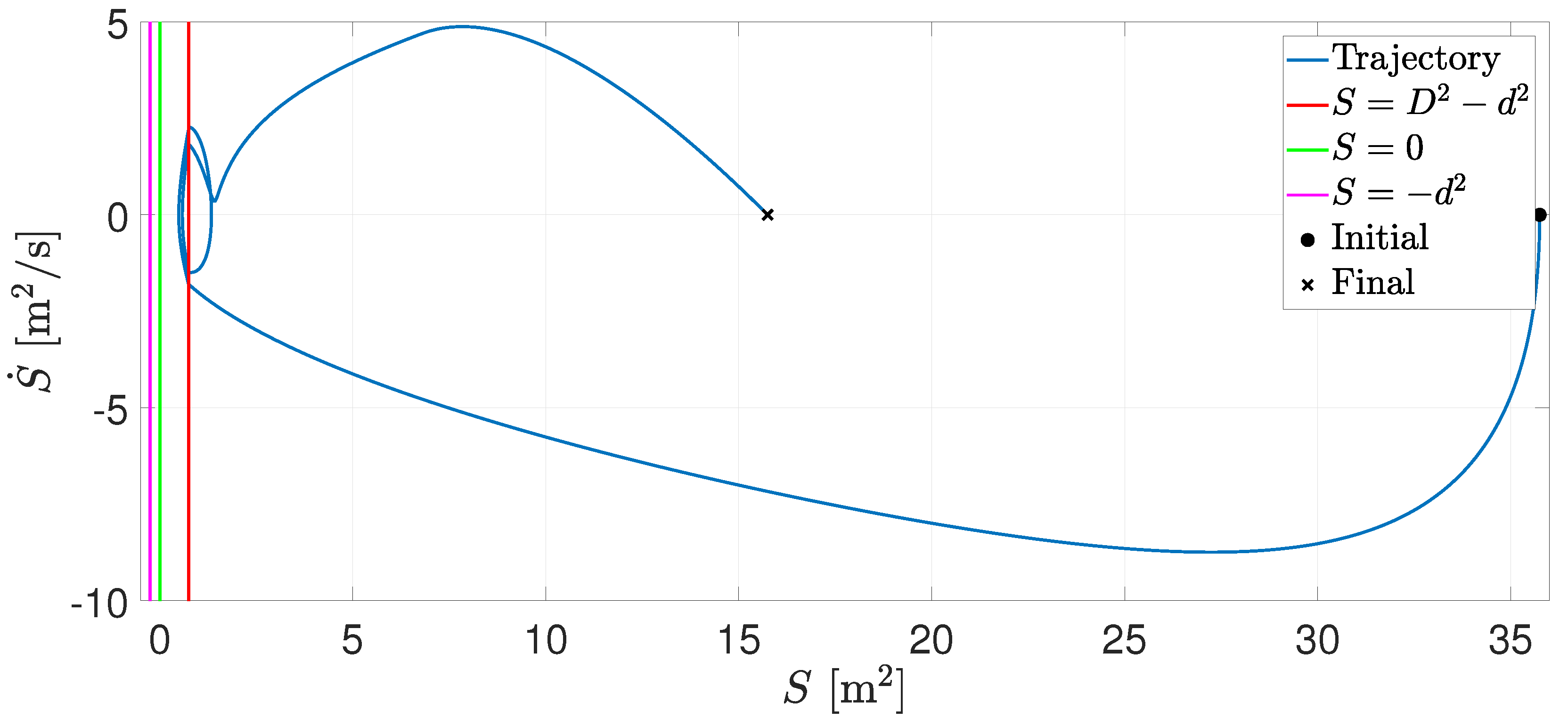
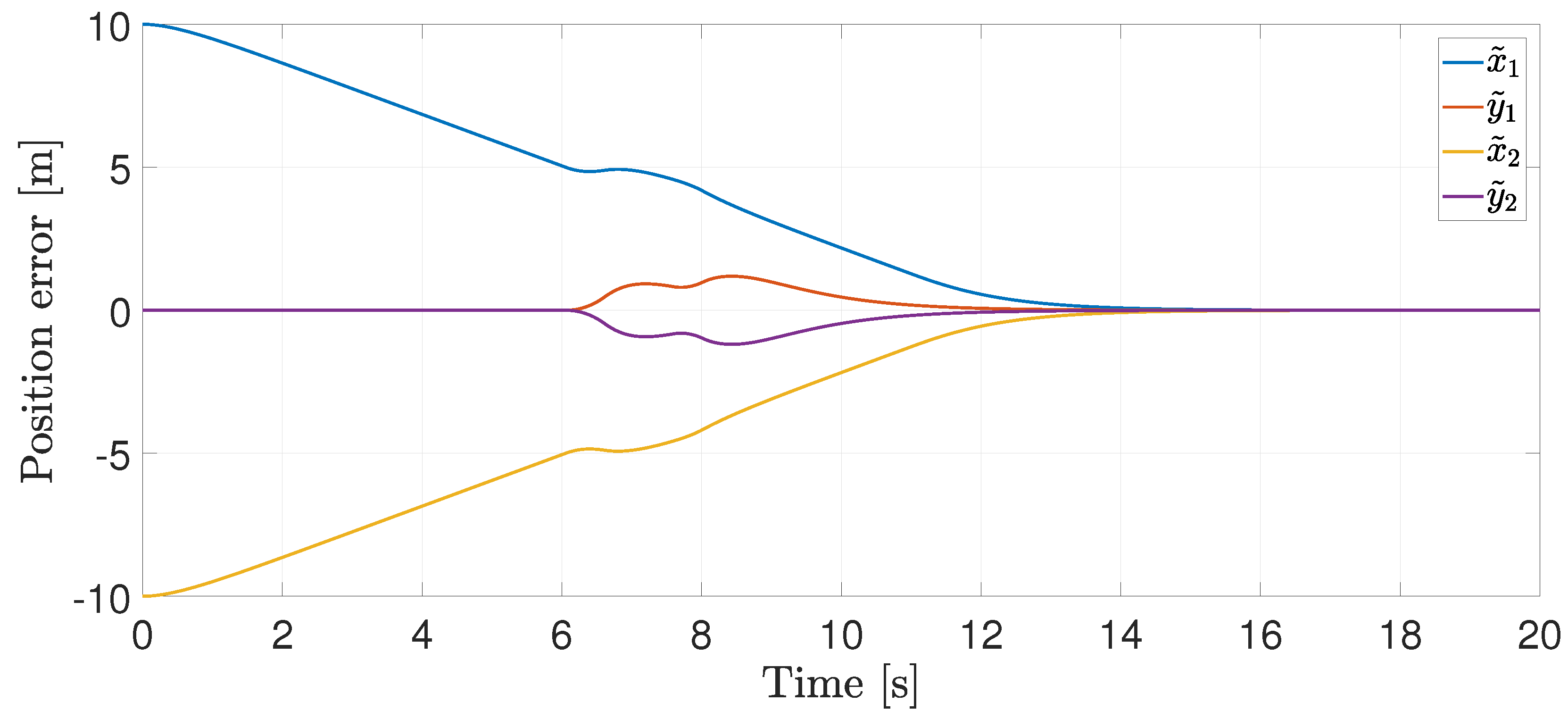


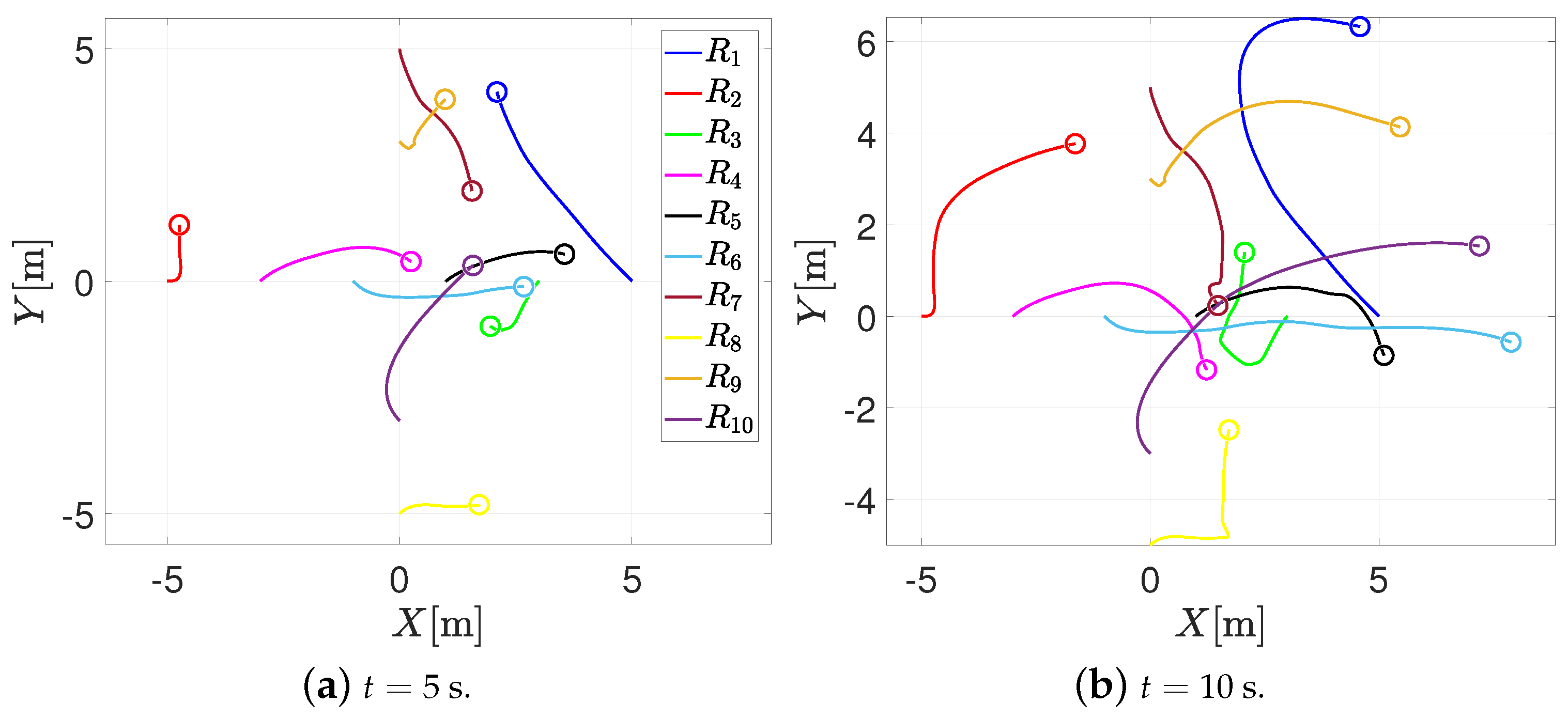
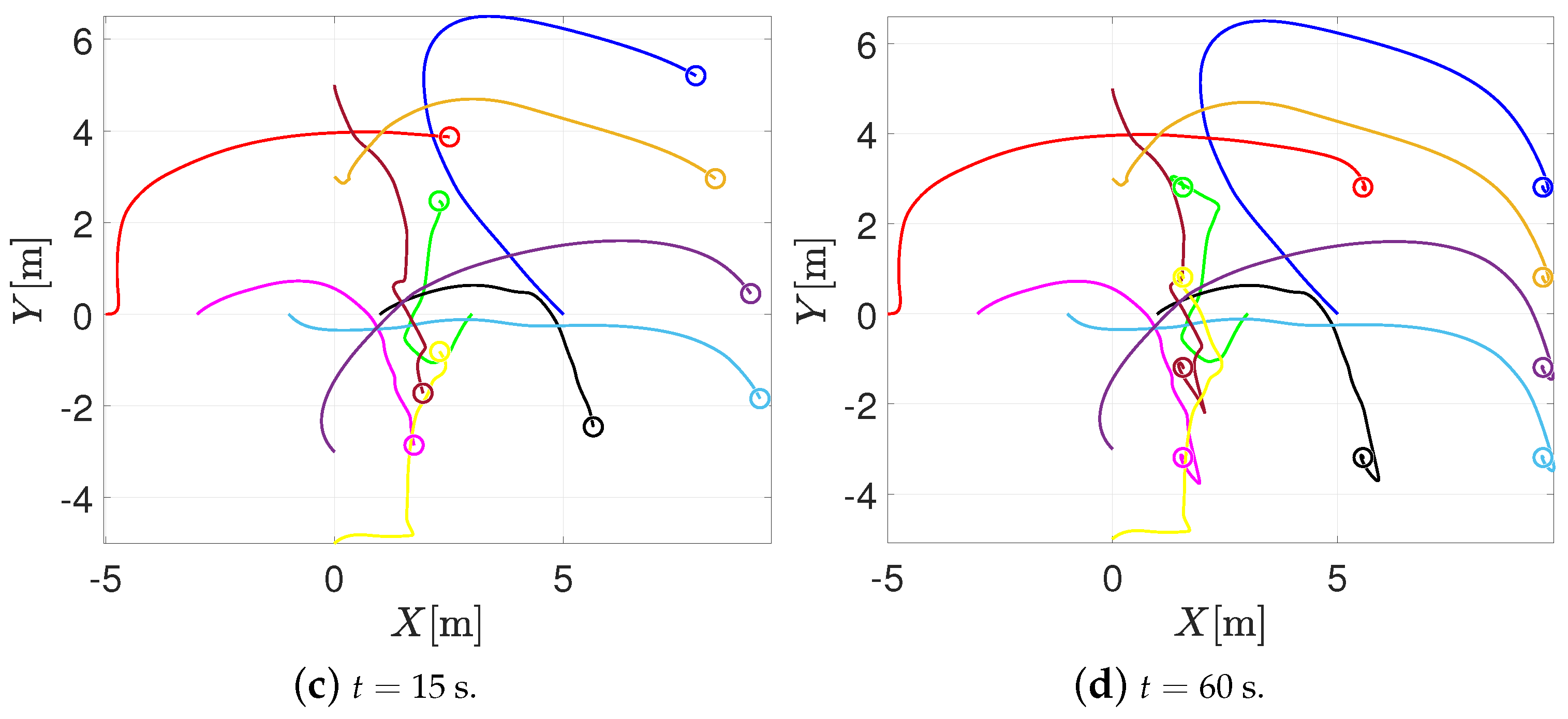
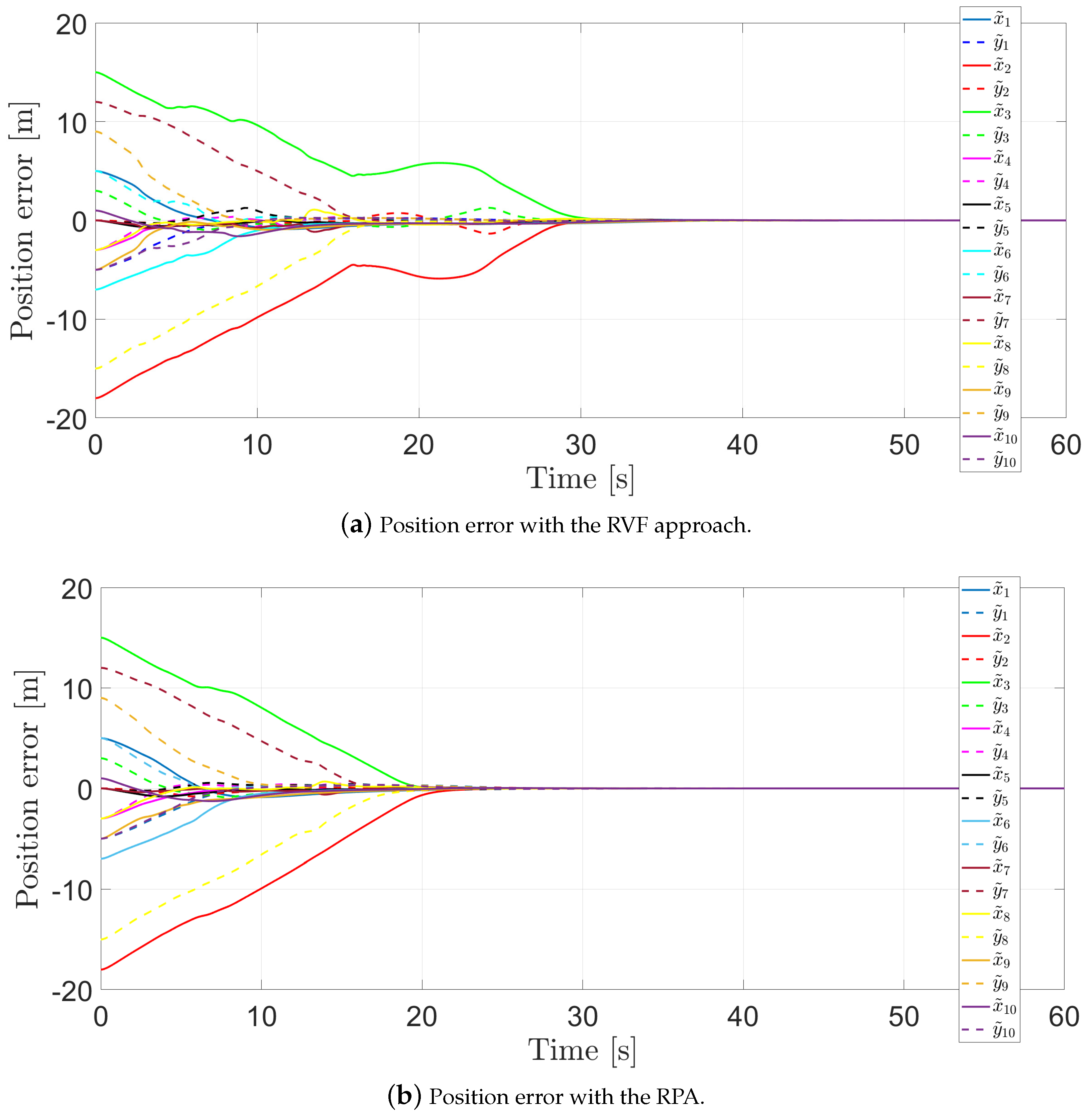
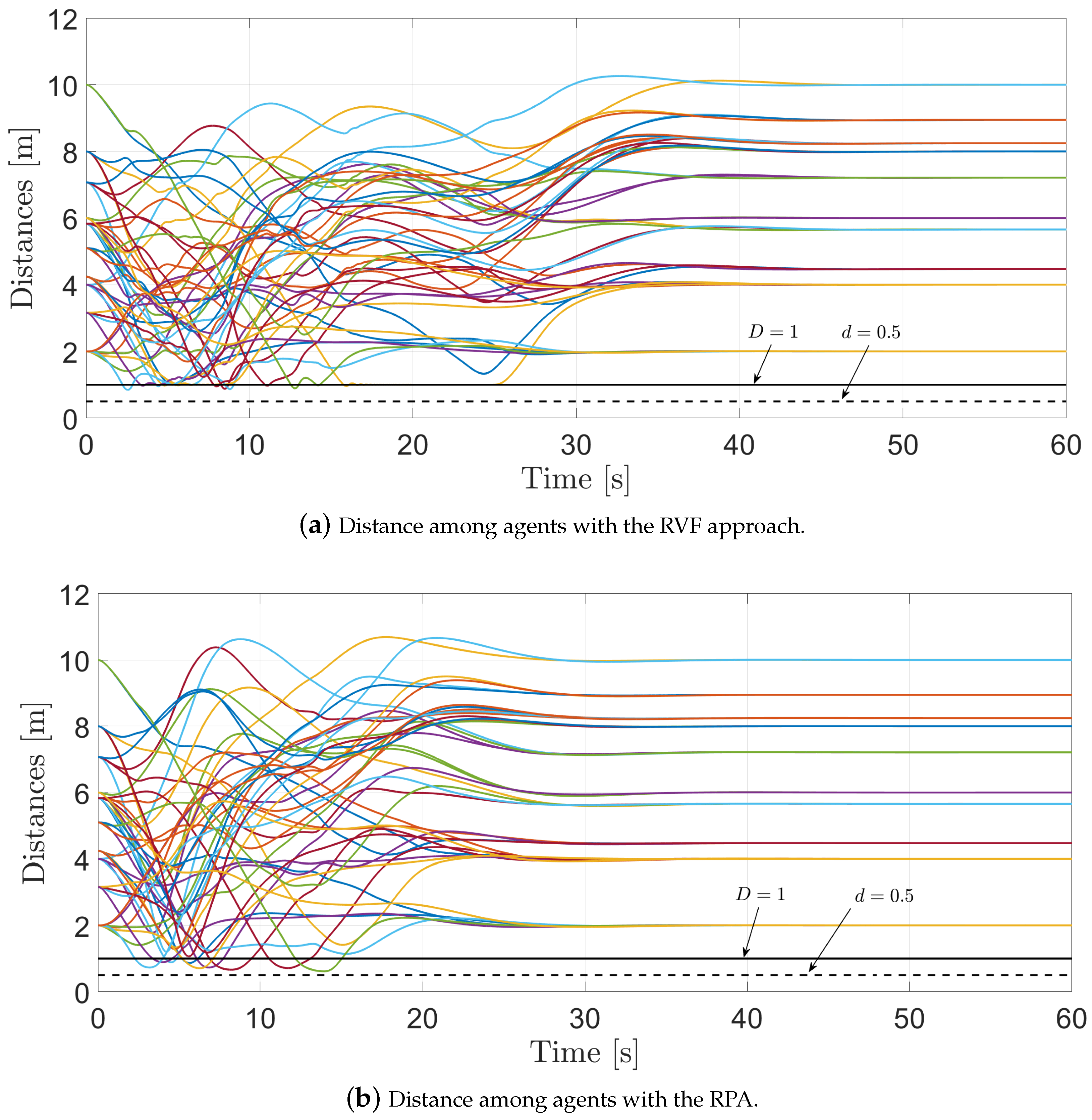
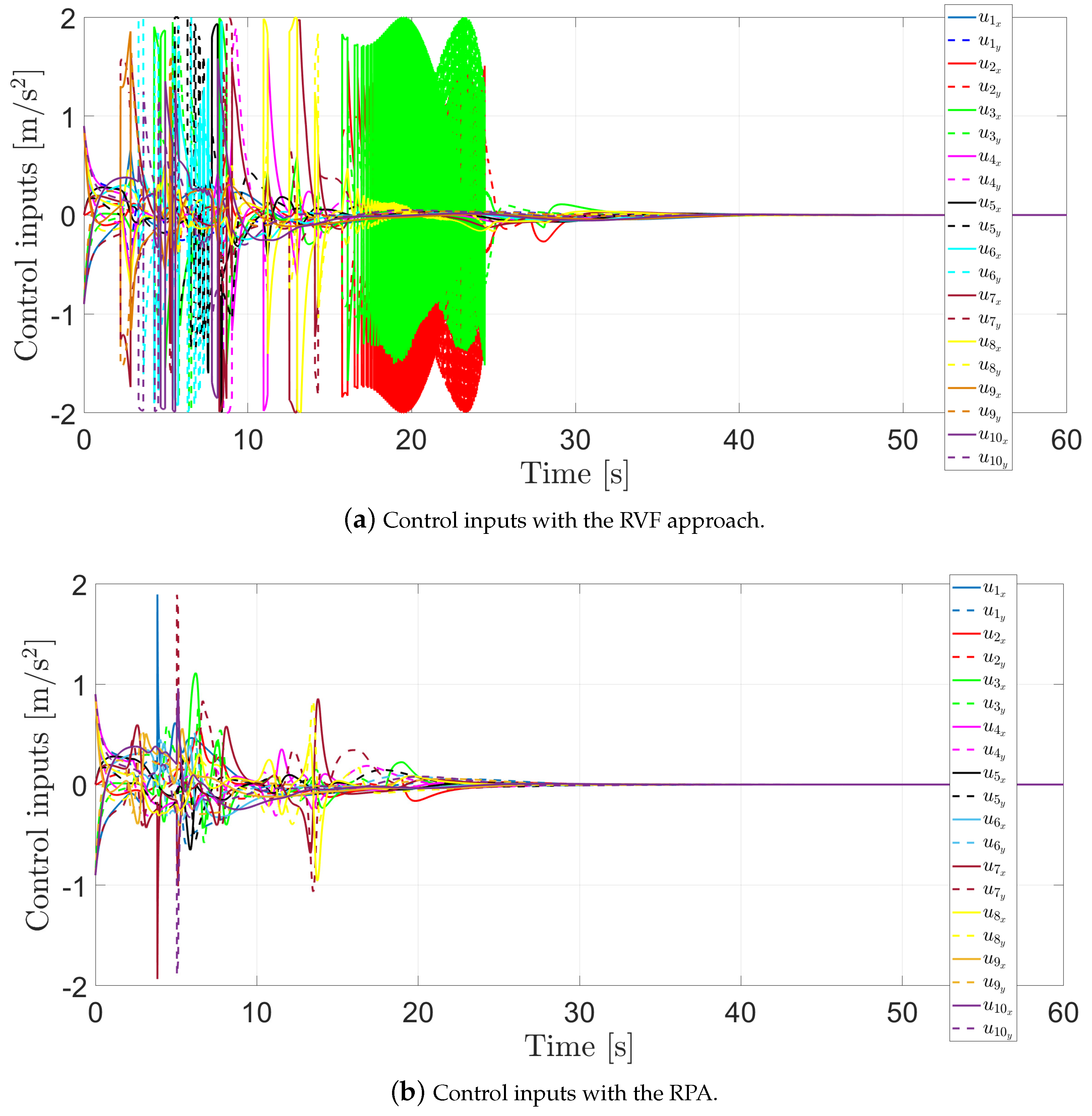
Disclaimer/Publisher’s Note: The statements, opinions and data contained in all publications are solely those of the individual author(s) and contributor(s) and not of MDPI and/or the editor(s). MDPI and/or the editor(s) disclaim responsibility for any injury to people or property resulting from any ideas, methods, instructions or products referred to in the content. |
© 2023 by the authors. Licensee MDPI, Basel, Switzerland. This article is an open access article distributed under the terms and conditions of the Creative Commons Attribution (CC BY) license (https://creativecommons.org/licenses/by/4.0/).
Share and Cite
Aranda-Bricaire, E.; González-Sierra, J. Formation with Non-Collision Control Strategies for Second-Order Multi-Agent Systems. Entropy 2023, 25, 904. https://doi.org/10.3390/e25060904
Aranda-Bricaire E, González-Sierra J. Formation with Non-Collision Control Strategies for Second-Order Multi-Agent Systems. Entropy. 2023; 25(6):904. https://doi.org/10.3390/e25060904
Chicago/Turabian StyleAranda-Bricaire, Eduardo, and Jaime González-Sierra. 2023. "Formation with Non-Collision Control Strategies for Second-Order Multi-Agent Systems" Entropy 25, no. 6: 904. https://doi.org/10.3390/e25060904
APA StyleAranda-Bricaire, E., & González-Sierra, J. (2023). Formation with Non-Collision Control Strategies for Second-Order Multi-Agent Systems. Entropy, 25(6), 904. https://doi.org/10.3390/e25060904





